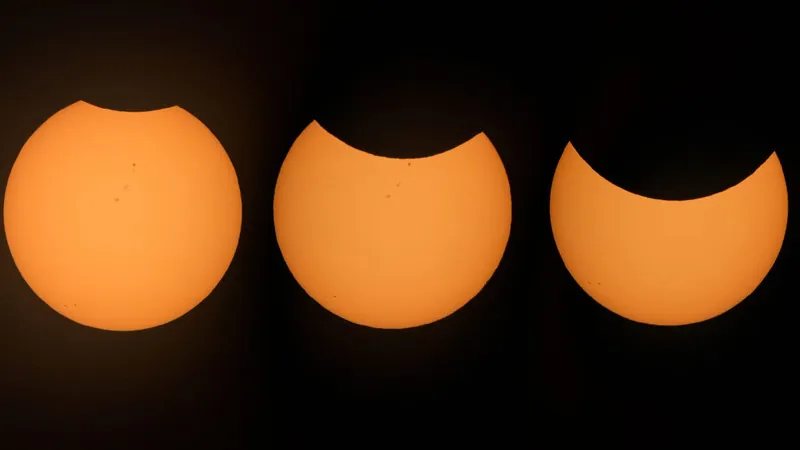
Don't Miss the 'Pac-Man Sun' Partial Solar Eclipse This Saturday! Here's How to Catch It
2025-03-28
Author: Siti
Get ready for a dazzling celestial event! Following the captivating 'blood moon' total lunar eclipse earlier this month, a partial solar eclipse is set to grace the skies at sunrise on March 29. While the best views will be from specific regions in the U.S., live streams will allow everyone to partake in this heavenly spectacle.
What is a Partial Solar Eclipse?
A partial solar eclipse occurs when the moon passes between the Earth and the sun, only partially obscuring the sun’s rays and casting a shadow on Earth. On this occasion, the moon's positioning won’t fully cover the sun; instead, it will leave a striking 'bite' taken out — reminiscent of a glowing cookie with a chunk missing. NASA advises that those hoping for a total eclipse will be disappointed as the moon's shadow won't align perfectly with Earth's surface this time.
Why You Shouldn't Skip This Partial Eclipse
Emily Rice, an associate professor of astrophysics at the Macaulay Honors College at CUNY, states, “This will be a photogenic event.” She emphasizes the opportunity for stunning photos with the sun low in the sky, allowing observers to frame the 'Pac-Man sun' with local landscapes like trees and buildings.
Viewing Locations
Skywatchers in parts of North America, Africa, Asia, and Europe will have the chance to enjoy a glimpse of the eclipse. Prime viewing spots will include northeastern U.S. cities like Portland, Maine, which will experience 64% of the sun covered at its peak. Meanwhile, places like Baltimore can only expect about 3%. To find out where you fit in, you can check NASA's eclipse map or visit Timeanddate.com for specific details regarding timings and percentages.
When Does the Eclipse Occur?
In the northeastern U.S., don’t snooze through this event! The eclipse will begin just as the sun rises; for instance, in Boston, the action starts at 6:31 a.m., and in Baltimore, it's at 6:55 a.m. Be ready to witness a fleeting moment as the eclipse will run for just a short while!
Livestreaming the Eclipse
Not everyone will be in the eclipse's path, but you don't have to miss out! Timeanddate.com will host a livestream starting at 5:30 a.m. ET on March 29, ensuring viewers can watch the action unfold in real-time. The Royal Observatory Greenwich in the UK will join the fun with its coverage starting at 6:00 a.m. ET.
Eye Safety First!
Unlike lunar eclipses, solar eclipses require careful eye protection. NASA strongly stresses the importance of using certified solar eclipse glasses to avoid severe eye damage. Keep your 'eclipse glasses' handy; these special viewers allow safe viewing of the sun even without the eclipse.
In case you don't have the necessary eyewear, consider crafting a simple pinhole projector. By positioning yourself away from the sun, you can easily project the sun's eclipse shape onto a surface.
A Cosmic Event Not to Be Missed
Both solar and lunar eclipses are unique opportunities to appreciate the wonders of our universe. Make plans to step outside for a moment of awe-inspiring celestial beauty. Prepare to grab your camera and perhaps some snacks as you soak in this cosmic trick of light!



 Brasil (PT)
Brasil (PT)
 Canada (EN)
Canada (EN)
 Chile (ES)
Chile (ES)
 Česko (CS)
Česko (CS)
 대한민국 (KO)
대한민국 (KO)
 España (ES)
España (ES)
 France (FR)
France (FR)
 Hong Kong (EN)
Hong Kong (EN)
 Italia (IT)
Italia (IT)
 日本 (JA)
日本 (JA)
 Magyarország (HU)
Magyarország (HU)
 Norge (NO)
Norge (NO)
 Polska (PL)
Polska (PL)
 Schweiz (DE)
Schweiz (DE)
 Singapore (EN)
Singapore (EN)
 Sverige (SV)
Sverige (SV)
 Suomi (FI)
Suomi (FI)
 Türkiye (TR)
Türkiye (TR)
 الإمارات العربية المتحدة (AR)
الإمارات العربية المتحدة (AR)